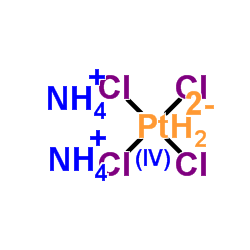Platinum(II)-ammonium chloride

Platinum(II)-ammonium chloride structure
|
Common Name | Platinum(II)-ammonium chloride | ||
|---|---|---|---|---|
| CAS Number | 13820-41-2 | Molecular Weight | 372.96700 | |
| Density | 2.936 g/mL at 25 °C(lit.) | Boiling Point | N/A | |
| Molecular Formula | H8Cl4N2Pt | Melting Point | 140 °C (dec.)(lit.) | |
| MSDS | Chinese USA | Flash Point | N/A | |
| Symbol |



GHS05, GHS06, GHS08 |
Signal Word | Danger | |
|
Platinum complexes and pyruvate kinase activity.
Gen. Physiol. Biophys. 17(1) , 25-36, (1998) The interaction of platinum complexes with bovine heart pyruvate kinase (PK) was studied by absorption, CD, fluorescence spectroscopy and enzymic activity test. Our results showed that activity of PK was reduced by cis-DDP and potassium tetrachloroplatinate i... |
|
|
Optimization of the efficiency of cross-linking PtII oligonucleotide phosphorothioate complexes to complementary oligonucleotides.
Nucleic Acids Res. 18(17) , 5163-71, (1990) We have investigated the efficiency with which PtII complexes cross-link phosphorothioates of oligonucleotides to complementary DNA targets. The A and G residues 2-5 bases downstream from the 5'-phosphorothioate group are preferred sites for cross-linking. Re... |
|
|
Hyperthermia and platinum complexes: time between treatments and synergy in vitro and in vivo.
Int. J. Hyperthermia 11(4) , 575-86, (1995) To investigate the greatest therapeutic efficacy, we investigated the effect of scheduling on the cytotoxic interaction between hyperthermia and seven different platinum complexes in vitro and in vivo using the FSaII murine fibrosarcoma cells. Hyperthermia tr... |
|
|
Occupational immediate-type allergic asthma due to potassium tetrachloroplatinate in production of cytotoxic drugs.
Adv. Exp. Med. Biol. 755 , 47-53, (2013) Allergic immediate-type reactions by halogenated compounds of platinum (Pt) (platinum salts) have been described in workers in precious metal refineries and catalyst productions. In both industries there are exposures to many different Pt compounds. It is bel... |
|
|
Monitoring local disposition kinetics of carboplatin in vivo after subcutaneous injection in rats by means of 195Pt NMR.
J. Magn. Reson. 133(1) , 115-22, (1998) The anticancer drug carboplatin has been monitored in rats during treatment by means of in vivo 195Pt NMR spectroscopy at 2.0 T. The purpose of the study was to assess local disposition kinetics in intact tissue following subcutaneous injection of a platinum-... |
|
|
Immunostimulatory effects of platinum compounds: correlation between sensitizing properties in vivo and modulation of receptor-mediated endocytosis in vitro.
Int. Arch. Allergy Immunol. 112(2) , 125-32, (1997) The sensitizing properties of different complex salts of platinum were defined in vivo by means of the popliteal lymph node (PLN) assay in mice. Hexa- and tetrachloroplatinates were confirmed to be highly immunogenic, inducing vigorous primary immune response... |
|
|
Dendrimer-tetrachloroplatinate precursor interactions. 2. Noncovalent binding in PAMAM outer pockets.
J. Phys. Chem. A 111(5) , 945-53, (2007) Density functional theory is used to investigate the complexation ability of dendrimer outer pockets--in both tertiary amine protonated and unprotonated scenarios--toward molecular guests, particularly tetrachloroplatinate(II) and its mono- and diaquated deri... |
|
|
Preparation of platinum(II) complexes with L-serine using KI. X-ray crystal structure, HPLC and 195Pt NMR spectra.
J. Inorg. Biochem. 97(2) , 240-8, (2003) The preparation of platinum(II) complexes containing L-serine using K(2)[PtCl(4)] and KI as raw materials was undertaken. The cis-trans isomer ratio of the complexes in the reaction mixture differed significantly depending on whether KI was present or absent ... |
|
|
A case of contact hypersensitivity to platinum salts.
Contact Dermatitis 43(4) , 226, (2000)
|
|
|
Impact of K2PtCl4 on the structure of human serum albumin and its binding ability of heme and bilirubin.
J. Inorg. Biochem. 53(4) , 249-60, (1994) Absorption, CD, gel-filtration chromatography, and immunological tests were used to evaluate the interactions of K2PtCl4 with human serum albumin. Multidentate coordination of Pt(II) to HSA causes distinct variations in the protein conformation including a co... |